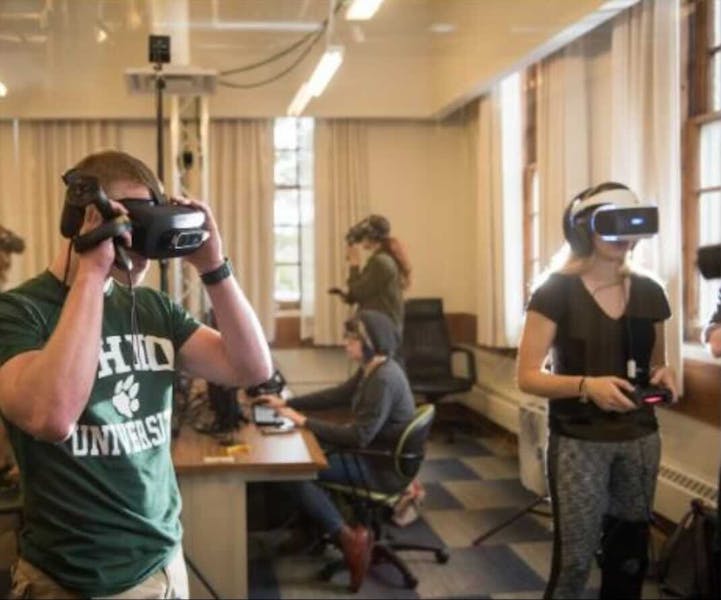Because its opening in 2005, the Sport Research and Immersive Style (GRID) Lab at Ohio University has been striving to deliver Appalachian Ohio with training and instruction in digital recreation technology.
A single of the focuses of the Lab is exploring and building virtual, augmented and blended reality. A short while ago, the GRID Lab collaborated with OhioHealth in an energy to ease the anxiety of COVID-19 on health care workers. The Lab developed a tranquil VR encounter, hoping to supply health care workers with a couple of minutes of peace throughout their active days.
The Post sat down with Matthew Love, a cineVR and film cinematographer, submit production manager and media lecturer at OU, to talk about the collaboration.
The Write-up: Inform me about the GRID Lab’s challenge with Ohio Wellness.
Really like: The way that it came to be is I was on a group phone for a grant job past slide with Dr. Elizabeth Beverly from the Heritage Higher education of Osteopathic Drugs, alongside with numerous people from OhioHealth. We have been speaking about the opportunity to submit a new grant software. The people from OhioHealth allow us know that they have been going to have to postpone the work on the grant due to the fact of the simple fact that so lots of men and women who typically had desk jobs ended up currently being identified as to the flooring to treatment for patients, just mainly because of the point that the wellness care method was under this kind of stress.
It was at that issue it turned to far more typical conversation. Liz and I had been in discussions prior to that on our very own about our drive to leverage digital truth to help in some way form or sort in reaction to the pandemic. And we had some tips that ended up form of an amalgamation of diverse factors that we have finished here. In addition to issues that we experienced either read or read about from other get the job done staying accomplished with digital actuality across the region.
We introduced the plan to them type of on a whim to offer headsets in OhioHealth facilities that would have tranquil, tranquil material on it. That could possibly offer team, medical professionals, nurses, receptionists, protection guards, custodians, whoever, who are pressured or pressured out by the predicament, a opportunity to escape and just take their two, 3, five minutes of their day and just be transported someplace else. OhioHealth liked the concept and stated that they observed that as a little something that experienced likely, and that they would be really interested in implementing or tests a number of of their services.
TP: What was the process like for producing the tranquil encounter?
Really like: I contacted Professor Nancy Stevens. She had been partnering with the GRID Lab, alongside with a regional character protect, to doc the preserve in its diverse seasons with pretty large end VR material. We ended up heading to various locations in the course of the reserve to capture the diverse seasons. I contacted Nancy and explained, ‘What do you feel about most likely utilizing some of the written content you’ve gotten from the character protect to help facilitate this pilot program with OhioHealth?’ and she liked the strategy. We have been ready to leverage some of that material from the Mother nature Protect. We set that in headsets and created that obtainable at 3 various OhioHealth services that were identified by OhioHealth as COVID hotspots. We experienced headsets at Riverside in Columbus, alongside with Grant Professional medical in Columbus and Marion Standard in Marion. These headsets have been produced available for any hospital worker from medical practitioners on down to just get a very little bit of a split.
TP: What was the opinions like from the 3 hospitals?
Enjoy: Liz labored with OhioHealth in the improvement of a easy measurement device so that we can, without the need of introducing any more strain to (the healthcare workers’) life, get an notion of no matter if or not this was successful. Primarily we did a 10-level scale, the place users self-claimed how pressured they felt prior to placing the headset on, to how pressured they felt when they took the headset off. One query likely in, one dilemma coming out. We have gotten that facts again, and it was quite promising. It was really encouraging. We are now in talks with OhioHealth to grow the challenge. So we want to get a higher assortment of encounters on the headsets, and we want to get the headsets at many additional services across their community.
Heading ahead, the GRID Lab is hoping to create a wide range of tranquil experiences for buyers to opt for from. For instance, a tropical beach or dense forest. On top of that, the lab’s following move is determining how many headsets need to be at every facility and where the funding will occur from.
I will incorporate that John Bowditch, who is the director of the GRID Lab, has always been extremely supportive of ideas and assignments with the GRID Lab. In spite of (the OhioHealth challenge) not staying some thing that was funded or that was likely to provide monetary worth to the GRID Lab, John is the kind of director who will glance at it and say, ‘Is this a way for us to have a constructive effect on our local community?’ I actually recognize that about the GRID Lab — that we leverage what we have in conditions of our capacity and our assets to test to be a favourable influence on the student overall body and the better group that we are a aspect of in Southeast Ohio.
jc079419@ohio.edu












